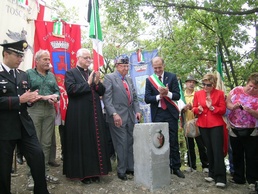
VERNIO, Italy — If the "Red Bull Nation" had a capitol city, it may very well be this small village 30 miles northwest of Florence. Nestled in the lush Tuscan hills, the peaceful and picturesque community today stands in stark contrast to a bloody battle fought between 34th Infantry Division forces and the German Army during World War II. The citizens of Vernio paused to remember the 65th Anniversary of the liberation of their town by Red Bull Soldiers in a ceremony, Sept. 20.
Sixty-five years ago, 133rd Inf. Regiment, 34th Red Bull Inf. Div. was advancing north through Italy to drive out German forces. The Germans built fortifications in the mountainous terrain from Tyrrhenian Sea plains near Massa on the west coast to the Adriatic Sea at Pesaro on the east in anticipation of the attack. This line of defense was dubbed "The Gothic Line" and Vernio held the strategic high ground, known on U.S. military terrain maps as "Hill 810."
The townspeople vividly remember the battle and gathered recently to dedicate a marker indicating a mountain pass as "Via 34th Divisione di fanteria Red Bull," or the Red Bull Highway.
"It's important that we honor the Red Bull Soldiers and the Italian Partisans who paid dearly for freedom," said Paolo Cecconi, mayor of Vernio.
The commemorative marker was unveiled by 92-year-old veteran Don Singlestad, of Park Rapids, Minn. Singlestad, then a 27-year-old Tech. Sgt., fought in the battle of Hill 810, ultimately becoming one of three Americans to be awarded the Italian Medal of Valor, the equivalent of the U.S. Congressional Medal of Honor.
A remembrance ceremony was held on Hill 810 at Gothic Line Memorial Park near a monument honoring the war dead following the unveiling of the historical marker. Maj. Gen. Rick Nash, commanding general of 34th Inf. Div., said the efforts of the troops in the battle of Hill 810 will endure.
"I am inspired by what I see here 65 years after the war — prosperity, peace, and solemn remembrance of those who sacrificed for a cause that will endure," said Nash. "I will bring this back with me and share with the people of Iraq, and hold you as the model by which long-term peace will prevail."
On Sept. 20th, 1944, the 133rd "Ironman" Regt., now based in Waterloo with the Iowa National Guard, led the attack on Hill 810, with the 135th Inf. Regt., now based in Mankato with the Minnesota National Guard in reserve.
"Ninety-one Red Bull Soldiers died here, including the brigade commander," said Ricardo Bruni, a retired first lieutenant with the Italian Officers Association. "The Germans took months to build entrenchments, including tunnels through the mountain to aide in resupply. It was designed to be impossible to overrun."
The fighting was fierce, with Red Bull troops forced to sustain an attack up steep and mountainous terrain over a period of eight days against the seasoned German 334th Infantry.
The land is still scarred with the remnants of battle. Rusting shrapnel from the intense artillery barrages still litter the ground. A farm house destroyed during the siege remains, as does evidence of U.S. foxholes built to provide cover from German machine gun fire. The most prominent remnants, however, are the German fortifications. Man-made caverns concealing mortar and machine gun positions still provide hilltop views of any possible advance.
"The sophistication of the German defensive positions was impressive," said Nash during a tour of the battlefield. "The fact that our Soldiers succeeded in defeating these positions by attacking up such rugged terrain is a testimony to our Red Bull predecessors' bravery and determination."